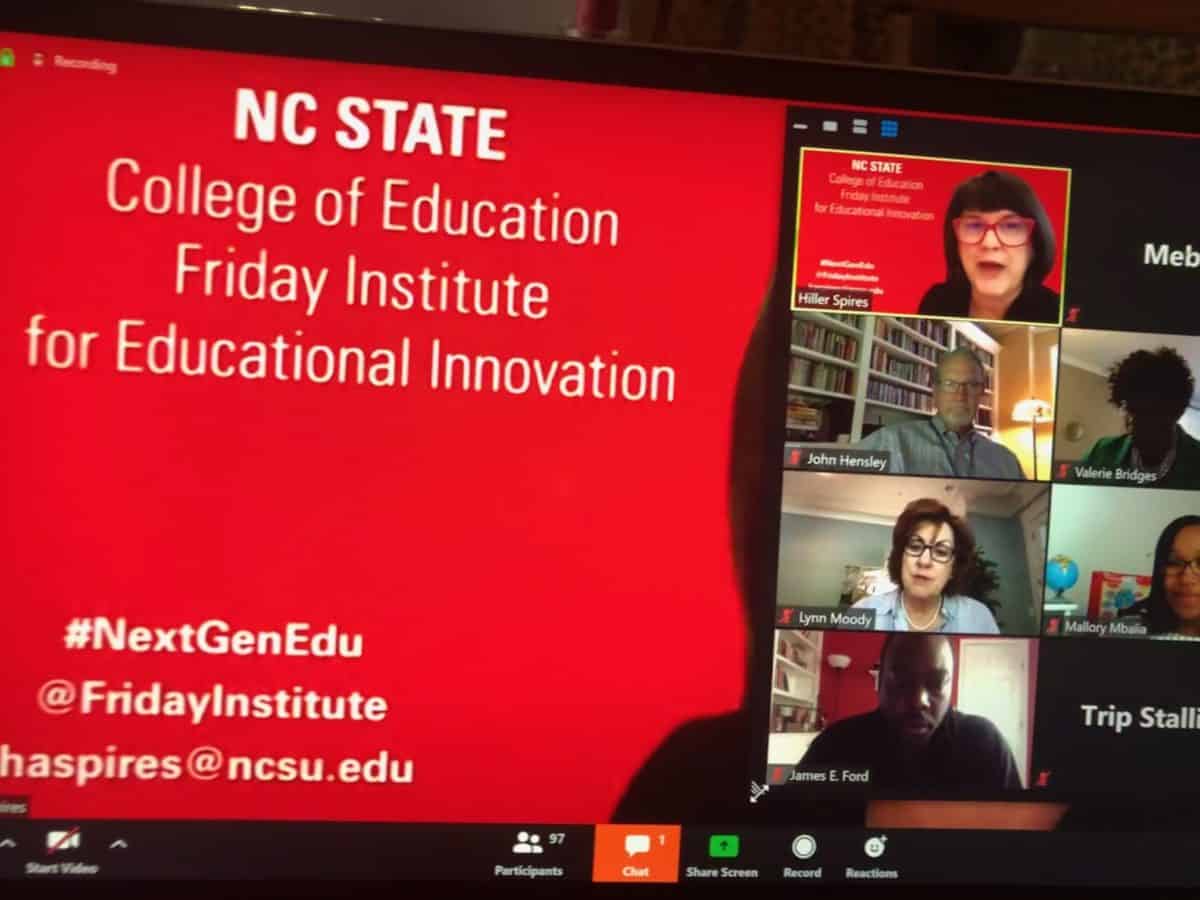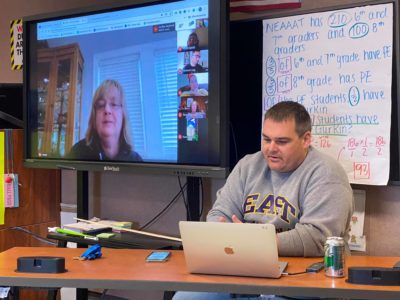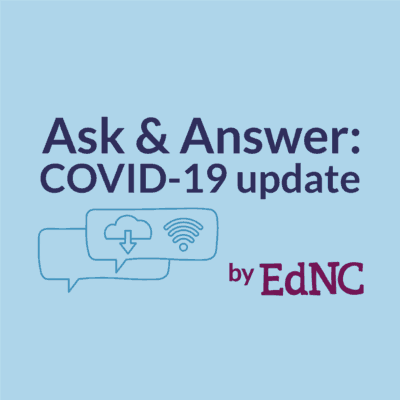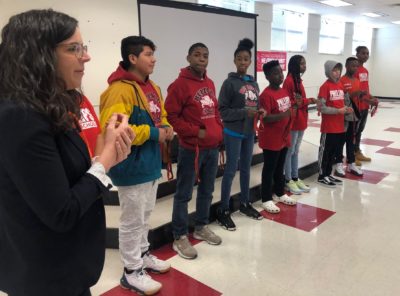

“Can we use this crisis to think futuristically about how we can meet the needs of all learners?”
That was the question being asked and answered in the second virtual, cross-sector discussion yesterday hosted by the Friday Institute for Educational Innovation (FI) at N.C. State. Dr. Hiller Spires, the executive director of the FI, moderated the conversation, which included Dr. Valerie Bridges, superintendent of Edgecombe County Public Schools; Dr. Lynn Moody, superintendent of Rowan-Salisbury School System; John Hensley, teacher and social studies department chair at Southeast Raleigh Magnet High School; Mallory Mbalia, director of educational engagement at UNC-TV; and James Ford, a member of the State Board of Education and executive director of CREED (Center for Racial Equity in Education).
The panelists were asked for specific examples of how they are addressing educational inequities during the COVID-19 crisis, about lessons learned, and the actions needed moving forward. Almost 100 people listened in.
“We know that prior to COVID, we’ve had a persistent achievement gap and educational attainment gap,” said Spires. “We know that the effects of the current crisis are experienced the most intensively by the most vulnerable in our society, for example students living in poverty, those with disabilities, immigrants, people of color, and those who are living in challenging family situations. But we are also witnessing educators as they create heroic responses to this crisis.”
What is equity? It’s the equality of opportunity, said Ford. Here is the definition he offered during the conversation:
Leading on equity with Superintendent Bridges
“The inequities existed before school closure was enacted. This pandemic with school closure has amplified the gap for students and families.” — Valerie Bridges
Bridges said that in her high-needs, student-centered district, nothing can replace face-to-face student interactions with a teacher. To fill in the gaps, teachers, principals, and student support services including counselors, nurses, social workers, and those working with exceptional and migrant students are all making “a gallant effort to reach out to students, every student, to make sure they have a connection.”
Bridges said the district “cannot afford for any of our students to be off the grid and for us not to be able to contact them.”
That’s complicated because in certain parts of Edgecombe County there isn’t any access to the internet. Bridges said, “That’s a barrier for us. We were aware of that before this crisis, we had talked about it before this crisis, and because now we need to have access for daily interactions with students, now it’s huge, now it’s that gaping hole that kind of spreads as it becomes urgent.”
Bridges said her district needs a “quick fix” when it comes to broadband access.
The district’s comprehensive approach to meeting the needs of students includes addressing food insecurity, providing a hotline for parents including tech support, professional development and support for teachers, and continuing to address student’s mental health concerns.
Leading on equity with Superintendent Moody
“It’s a good time to be positive about the future.”
— Lynn Moody
The Rowan-Salisbury School System, which is known as a renewal school district, “provides charter-like flexibilities for all 34 Rowan-Salisbury Schools. Teachers will be empowered to lead, design, and create how instruction is offered to students,” according to the district’s website.
About five years ago, the Rowan-Salisbury School System became a 1:1 district so students and parents could have access to information outside of school. Moody says they provided devices students and families could use even without internet, learned a lot about who to partner with on software for the devices, provided professional development so students, parents, and teachers could use the devices, and built a strong infrastructure to support effective use of the devices.
During the crisis, the parking lots at all 34 schools in the district are open morning to night so families and communities can “tap on to our internet.” The district is using hot spots to close additional gaps. And still, Moody says, they have been in little to no contact with 1,100 of about 20,000 students.
And while the district works to contact each and every student, Moody says, “We are continuing to think about how to keep innovation in our DNA.”
“We learned you can’t do daily lessons when people are in a crisis. You have to think holistic[ally] about a bigger picture of learning, which is wonderful,” she said. “Often, students and equity issues exist because we are constantly talking about students gaps and deficits, and if we spent more time talking about students strengths and the things they bring to the table and enhancing those, I think we would serve our students better.”
Moody is meeting and talking with students about what they want school to look like going forward.
This article features Moody talking more in-depth about what her district is doing to take advantage of this crisis.
Leading on equity with teacher John Hensley
“You need 1:1 for all the students in the house. They need their own dedicated device, and we are miles away from getting to that point.” — John Hensley
Hensley teaches in southeast Raleigh, and while connectivity is not an issue for most of his students, his school has realized that for many students, there are not enough devices in the household to go around — for parents and all the school-aged children to work and study online. For some students, the only devices in the house, they realized, are cell phones.
The two other issues that have arisen involve getting a grasp on pacing for students when teachers are making online assignments and being clear on grading with students and parents.
Leading on equity with James Ford
“What is it we want to build?” — James Ford
Take a listen to James Ford talk about why the status quo didn’t work, and the radical imagination needed to build a truly equitable education system.
Ford serves on the State Board of Education, and he also discussed the guidance the Board has issued on remote learning, and specifically the five critical factors for effective remote learning, including:
- accessible by all students for which the learning is intended and is responsive to diverse learning groups;
- maintains consistent communication between instructional staff and students;
- addresses the curricular and instructional needs associated with appropriate standards;
- includes evidence of student learning; and,
- considers the whole child as well as the home learning environment.
Ford said even before COVID-19, the State Board of Education was focused and committed to equity and a whole child approach to education.
Comments from attendees in the chat
“Our students in Edgecombe are telling us they are using this time to explore their passions and want to do more of that — in and out of school.”
“Equity is about promoting and supporting the individual strengths of every learner. The more we build relationships, talk about individual hopes and dreams, and help them network with places and people who can help them pursue their passions and the problems they want to solve.”
Resources
Here is the Department of Public Instruction’s site for “Remote Learning Resources and Information.”
Check out this at-home learning resource offered on the NC Channel on UNC-TV. The website says, “These closings have left thousands of students at home with reduced access to structured instruction. To address this educational gap, UNC-TV and the NC Department of Public Instruction are partnering to support school-age children learning at home by providing free, curriculum-informed, over-the-air content that is widely accessible to students — especially those with limited or no internet access. Each weekday, two blocks of programs on UNC-TV’s North Carolina Channel will serve students: fourth through eighth grade, from 8 AM-1 PM, and ninth through twelfth grade, from 1-6 PM.”
The next webinar hosted by the Friday Institute will be held on May 6. ICYMI, this article is about the first webinar in this COVID-19 series held by the Friday Institute.




